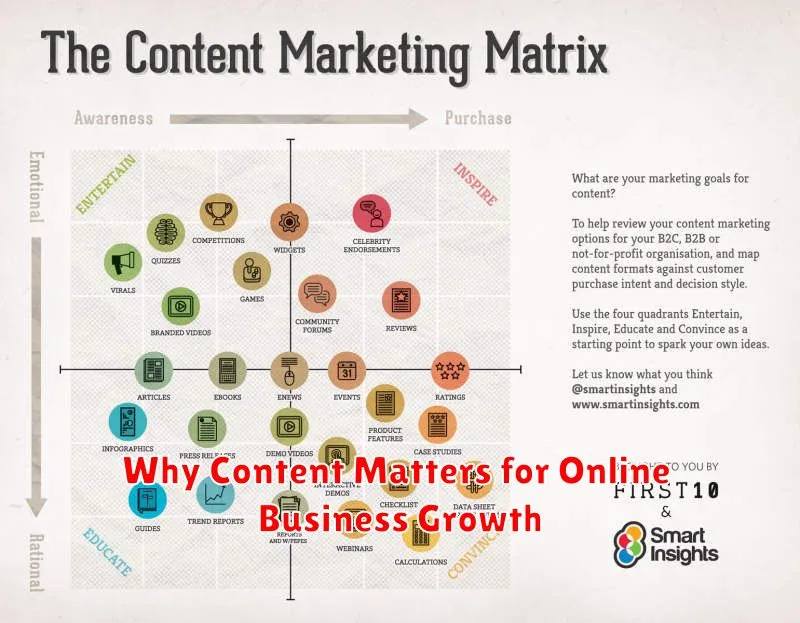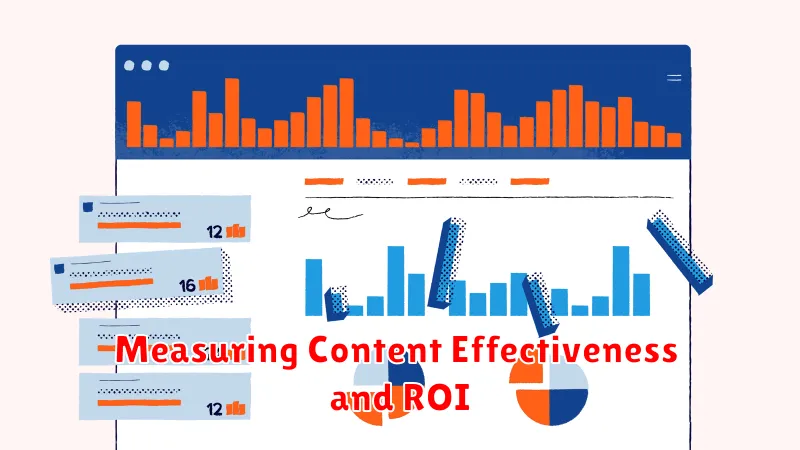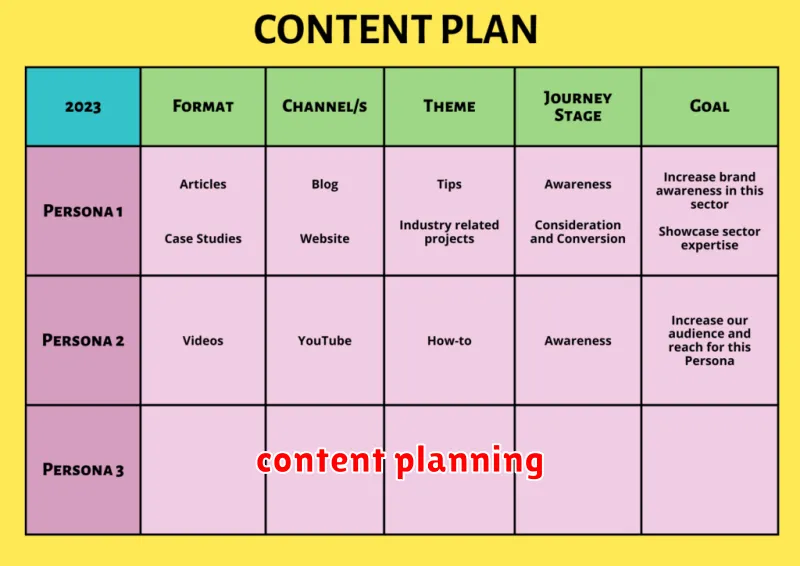Developing a robust content strategy is paramount for the success of any online business. This practical guide will equip you with the essential knowledge and actionable steps to create a content marketing plan that drives organic traffic, enhances brand visibility, and ultimately boosts your bottom line. We’ll explore effective content creation techniques, SEO optimization strategies, and methods for measuring and improving your content performance, enabling you to harness the power of digital marketing for sustainable growth.
Why Content Matters for Online Business Growth

In today’s digital landscape, content is paramount for online business growth. It acts as the foundation for attracting, engaging, and converting your target audience.
High-quality content establishes your brand as a thought leader in your industry. By consistently delivering valuable information, you build trust and credibility with potential customers.
Effective content improves your search engine optimization (SEO). Search engines prioritize websites that offer relevant, informative content, resulting in higher rankings and increased organic traffic.
Furthermore, content marketing drives lead generation. By providing valuable resources like ebooks, webinars, or blog posts, you attract potential customers and nurture them through the sales funnel.
Ultimately, engaging content fosters customer loyalty. By providing consistent value and building relationships, you cultivate a dedicated customer base that returns for more and advocates for your brand.
How to Plan and Organize Content Calendars
A well-structured content calendar is crucial for consistent online presence. Begin by defining your goals; what do you want to achieve with your content? This will inform your content pillars – the main topics you’ll focus on.
Next, brainstorm content ideas aligned with your goals and pillars. Consider various formats, such as blog posts, videos, infographics, and social media updates. This stage benefits from keyword research to identify relevant search terms.
Choose a calendar tool that suits your needs. This could be a spreadsheet, a dedicated content calendar software, or even a shared document. Populate your calendar with your content ideas, scheduling them strategically across the month or quarter. Consider seasonal trends and relevant events.
Assign responsibilities and deadlines to ensure accountability. Regularly review and adjust your calendar to reflect performance data and evolving priorities. This iterative process ensures your content remains relevant and effective.
Finally, track your progress. Monitor key metrics such as website traffic, engagement, and conversions to measure the success of your content strategy and make necessary adjustments for future planning.
Creating Value-Driven Blog and Social Media Content
Creating value-driven content is paramount for online business success. It’s not about simply posting frequently; it’s about providing relevant and engaging information that benefits your target audience. This approach fosters trust and loyalty, leading to increased brand recognition and conversions.
To achieve this, understand your audience’s needs and pain points. Conduct thorough keyword research to identify topics that resonate with them. Craft content that solves problems, answers questions, or provides valuable insights. This could include blog posts offering expert advice, social media updates sharing industry news, or videos demonstrating product usage.
High-quality content is crucial. Ensure your writing is clear, concise, and error-free. Use visuals like infographics or short videos to enhance engagement. Promote your content through various channels, utilizing a mix of organic and paid strategies to maximize reach.
Regularly analyze your content’s performance using analytics tools. Track metrics like engagement rate, website traffic, and conversions to identify what resonates with your audience and adjust your strategy accordingly. By consistently delivering valuable content, you cultivate a strong online presence and build a thriving online business.
Using SEO to Guide Your Content Topics

A robust content strategy hinges on understanding what your audience searches for. SEO (Search Engine Optimization) provides invaluable insights into this. By analyzing keyword research data, you can identify high-demand topics relevant to your business. This ensures your content addresses actual user needs, improving your website’s visibility and organic traffic.
Tools like Google Keyword Planner, SEMrush, and Ahrefs can reveal search volume, keyword competition, and related search terms. Understanding these metrics helps prioritize content creation, focusing on topics with high search volume and manageable competition. This strategic approach maximizes the impact of your content marketing efforts.
Beyond keyword identification, SEO guides content structure and optimization. On-page optimization techniques, such as incorporating keywords naturally within headings, subheadings, and body text, improve search engine rankings. Optimizing meta descriptions and image alt text further enhances visibility and user experience, leading to higher engagement and ultimately, improved conversion rates.
Remember that SEO is an ongoing process. Regularly monitor keyword rankings and website analytics to assess content performance and adapt your strategy accordingly. Continuously refine your content based on user behavior and search trends to ensure its long-term effectiveness.
How to Repurpose Content Across Platforms
Repurposing content maximizes your efforts and expands your reach. Instead of creating entirely new content for each platform, adapt existing material to suit different audiences and formats. This is a cost-effective strategy that saves time and resources.
Consider transforming a blog post into a series of short, engaging Instagram captions or a podcast episode. A detailed case study could be shortened into a series of LinkedIn posts highlighting key takeaways. Videos can be repurposed into blog posts with transcripts or bite-sized clips for TikTok or Twitter.
Key to success lies in understanding the unique characteristics of each platform. Tailor your message and format to resonate with the specific audience. For instance, visual platforms like Instagram and Pinterest prioritize compelling imagery, while LinkedIn favors professional insights and thought leadership.
Remember to always maintain a consistent brand voice and message across all platforms. This will enhance brand recognition and reinforce your overall marketing strategy. Thorough planning and scheduling will help streamline the repurposing process, allowing for efficient content distribution across your chosen channels.
Visual Content: Images, Videos, and Infographics
Visual content is crucial for a successful online content strategy. It breaks up text, improves engagement, and enhances understanding. Images should be high-quality, relevant to the topic, and optimized for web use. Consider using a consistent style to maintain brand identity.
Videos are particularly effective for demonstrating products or services, conveying complex information concisely, and building brand personality. Short, engaging videos perform best. Ensure good lighting, sound, and clear messaging.
Infographics are ideal for presenting data and complex information in a visually appealing and easily digestible format. They should be well-designed, easy to read, and highlight key takeaways. Prioritize clarity and avoid overcrowding.
Remember to optimize all visual content for search engines (alt text for images, descriptive titles for videos) and ensure consistent branding across all platforms.
Building Authority with Long-Form Content
In the crowded online marketplace, establishing authority is crucial for success. Long-form content plays a pivotal role in achieving this.
Comprehensive guides, in-depth tutorials, and detailed case studies demonstrate expertise and provide significant value to readers. This thoroughness positions your business as a trusted resource, fostering loyalty and driving organic traffic.
Unlike short-form content, long-form pieces allow for a deeper exploration of topics, enabling you to address complex questions and nuances comprehensively. This depth builds credibility and establishes your business as a thought leader in your industry.
Furthermore, long-form content tends to rank higher in search engine results pages (SERPs). Search engines reward in-depth, high-quality content, boosting your SEO performance and visibility. This increased visibility translates into more website traffic and potential customers.
By consistently creating valuable long-form content, you cultivate a loyal audience, build strong relationships, and solidify your business’s position as a respected authority in your niche. Remember to focus on providing real value and addressing your target audience’s specific needs and questions.
Measuring Content Effectiveness and ROI

Measuring the effectiveness of your content and its return on investment (ROI) is crucial for a successful online business. This involves tracking key performance indicators (KPIs) to understand how well your content is achieving its goals.
Website analytics are paramount. Tools like Google Analytics provide data on website traffic, bounce rate, time on page, and conversion rates. Analyzing this data helps determine which content resonates most with your audience and drives desired actions, such as purchases or lead generation.
Beyond website analytics, consider social media engagement metrics. Likes, shares, comments, and retweets indicate audience interest and content virality. Monitoring these metrics allows you to refine your content strategy and optimize for better reach and impact.
Lead generation and sales are ultimately the key measures of ROI. Track the number of leads generated from your content and how many of those leads convert into paying customers. This allows you to directly correlate content creation efforts with revenue generation.
Finally, A/B testing different content formats and headlines can reveal what works best for your target audience, helping you optimize for higher engagement and better ROI. Regularly reviewing and adjusting your content strategy based on data analysis is essential for sustained success.

